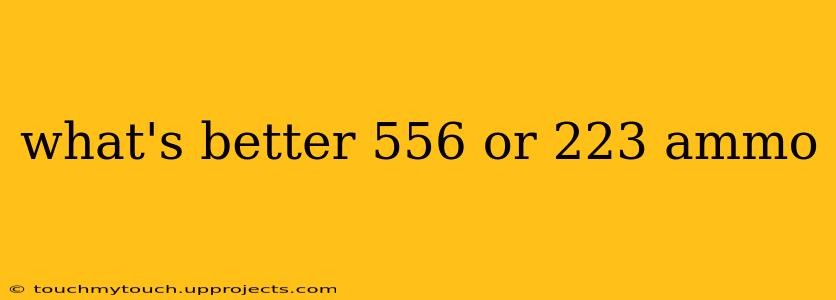5.56 vs .223 Ammo: What's the Difference and Which is Better?
Choosing between 5.56x45mm and .223 Remington ammunition can be confusing, especially for newcomers to the world of firearms. While they appear similar, and even interchangeable at first glance, there are crucial differences that affect accuracy, safety, and overall performance. This article will delve into the specifics, helping you understand which cartridge is right for your needs.
Understanding the Calibers: More Than Just a Name Difference
The core difference lies in the chamber specifications and pressure ratings. Both cartridges fire a .224-inch diameter bullet, but the 5.56 NATO round is chambered in a slightly different way. This seemingly minor variation has significant implications.
-
.223 Remington: This is the commercially available civilian round, designed for lower pressure. It's generally considered a bit gentler on firearms, leading to potentially longer barrel life.
-
5.56x45mm NATO: This is the military round, designed for higher pressure. It's more powerful, with higher velocity and flatter trajectory.
Key Differences Explained
Here's a breakdown of the key distinctions between 5.56 and .223 ammo:
| Feature | .223 Remington | 5.56x45mm NATO |
|---|---|---|
| Pressure | Lower | Higher |
| Velocity | Generally lower | Generally higher |
| Accuracy | Can be more accurate in some rifles | Can be more accurate in some rifles |
| Barrel Life | Potentially longer | Potentially shorter |
| Cost | Typically less expensive | Typically more expensive |
| Availability | Widely available | Widely available, but can vary |
| Intended Use | Civilian applications | Military applications |
The Danger of Interchangeability (or Lack Thereof)
While some firearms are designed to handle both calibers, firing 5.56 ammo in a .223 chamber is generally considered safe, albeit potentially leading to slightly higher pressure. However, firing .223 ammo in a 5.56 chamber is significantly riskier. The higher pressure of a 5.56 round can overstress a .223 chamber, causing potential catastrophic failure—leading to serious injury or death.
This is because the 5.56 NATO chamber is designed to withstand higher pressures than its .223 counterpart.
Which is "Better"? It Depends on Your Needs
There isn't a single "better" round; the ideal choice depends entirely on your specific application and firearm.
-
For civilian target shooting or hunting (with the appropriate caliber choice for game): .223 Remington is usually sufficient, offering good accuracy and lower cost.
-
For military or self-defense applications requiring maximum stopping power and penetration: 5.56x45mm NATO is preferred. Its higher velocity and flatter trajectory provide better performance at longer ranges.
-
Always consult your firearm's manual. It will explicitly state which caliber(s) are safe to use. Never compromise on safety when it comes to firearms.
Conclusion
The choice between 5.56 and .223 ammunition boils down to a nuanced understanding of pressure ratings and chamber specifications. Understanding these differences is vital for ensuring both safety and optimal performance. Prioritize safety, check your firearm's manual, and select the caliber that best suits your specific needs and intended use. Always practice safe firearm handling techniques.
